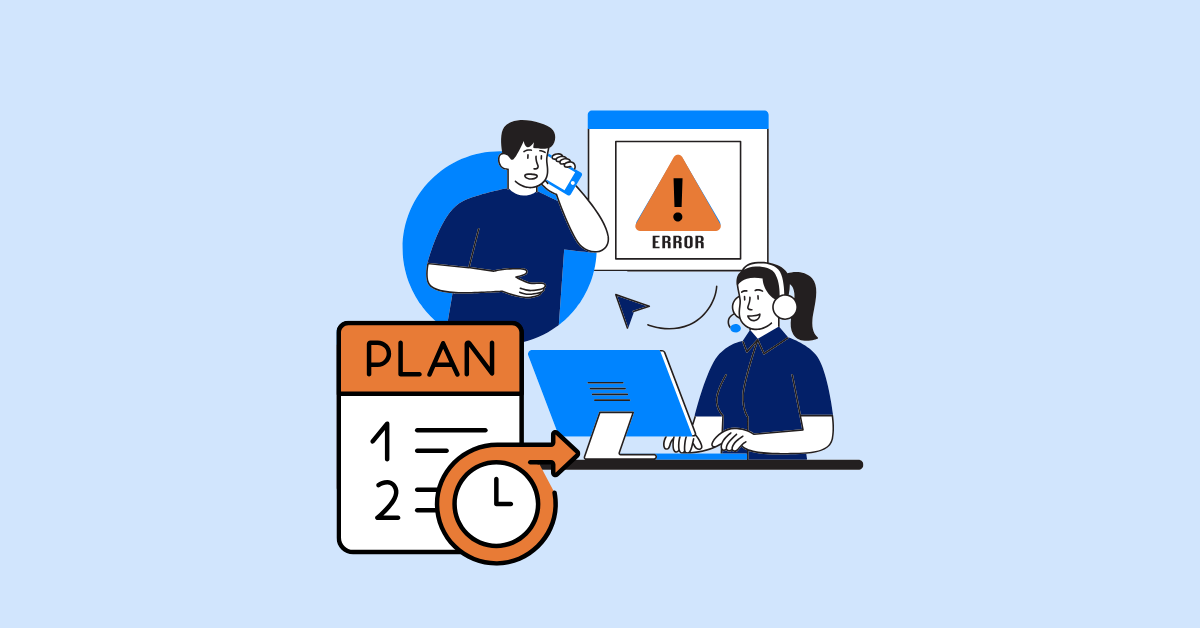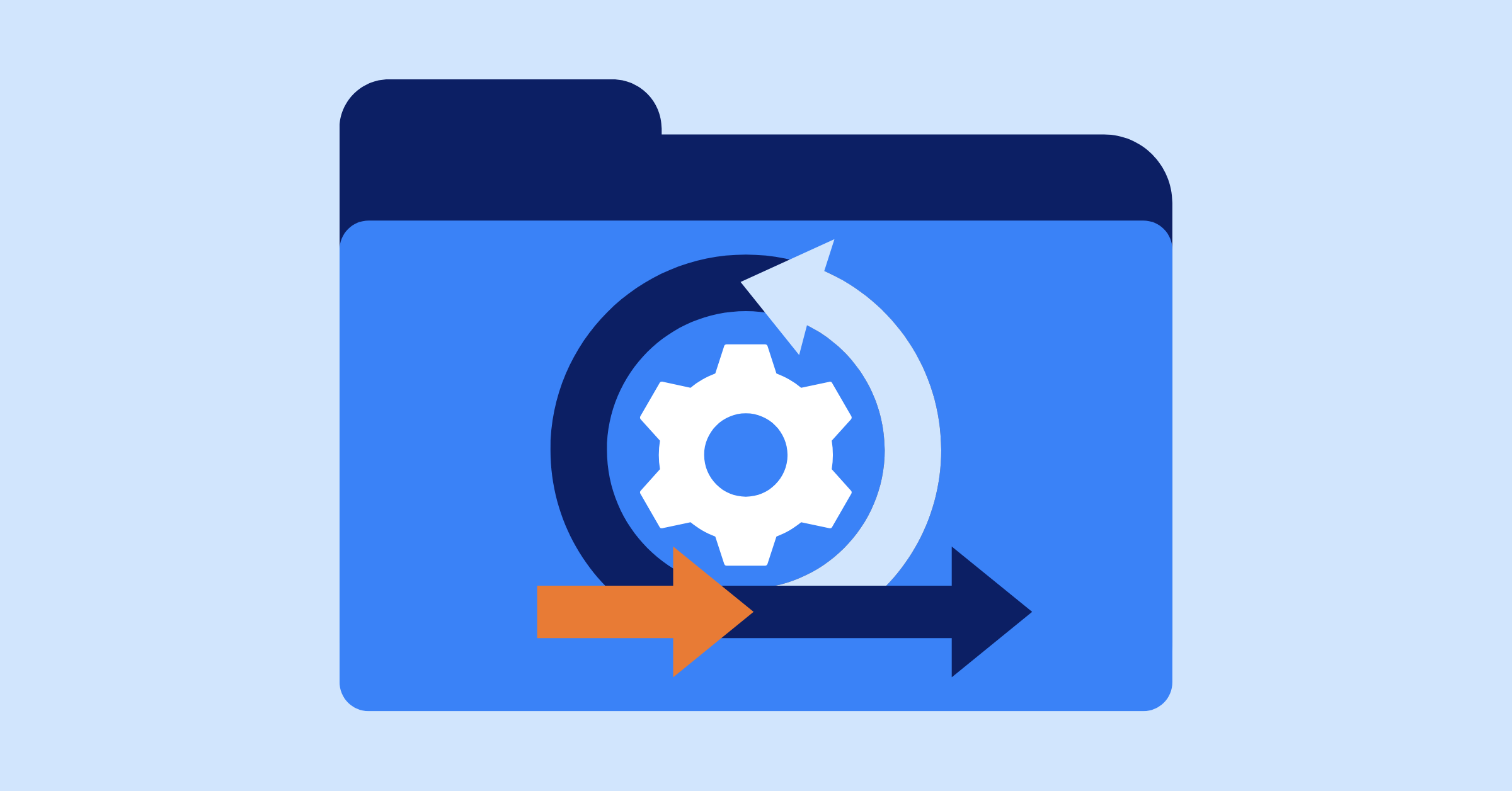How to Apply the 5 Levels of Agile Planning in Your Organization
Learn to apply the 5 levels of agile planning for aligned, effective project management. Practical steps and tools to boost agility and deliver value.
Agile promises flexibility, but without structure, teams often face chaos. Many organizations adopt Agile expecting streamlined workflows, only to find sprints misaligned with business goals. For example, a marketing team might deliver campaigns rapidly but fail to impact revenue due to unclear priorities. Agile doesn't mean no planning; it requires disciplined, multi-level planning to succeed. The 5 levels of agile planning provide a framework to balance adaptability with alignment, ensuring every task contributes to strategic objectives.
This article provides detailed, practical steps to implement the 5 levels of agile planning in your organization. From running a vision workshop to tracking success with a simple scorecard, you’ll learn how to make each level work effectively. By the end, you’ll have a clear, actionable roadmap to create a cohesive agile project management system that drives measurable value.
Understanding the 5 Levels of Agile Planning (and Why They Matter)
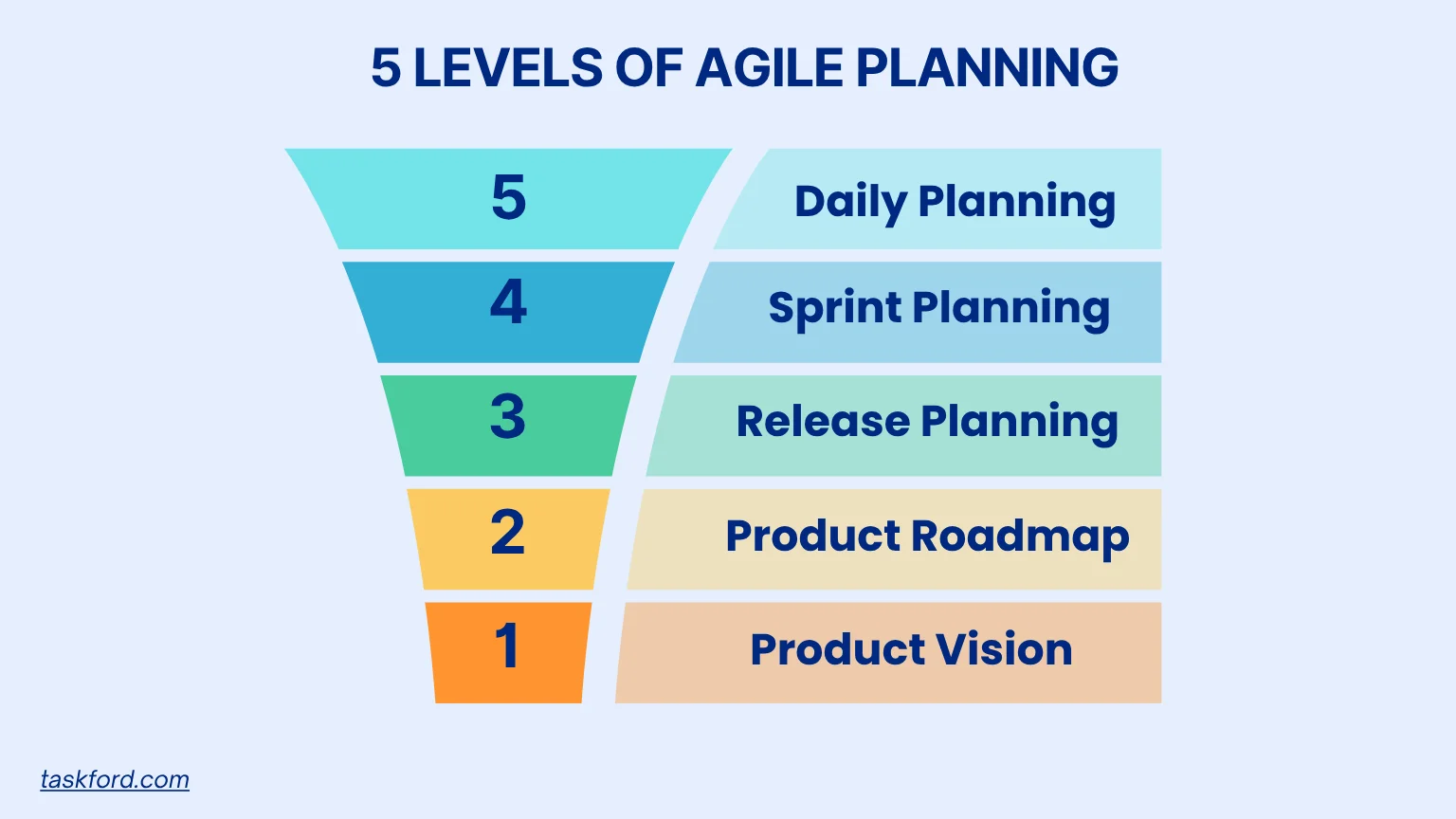
The 5 levels of agile planning create a structured framework that aligns strategic goals with tactical execution. Each level has a unique role, scope, and cadence, ensuring teams stay agile while connected to organizational objectives. Together, they prevent Agile from becoming chaotic, linking daily work to long-term vision. Here's a clear look at each level and its importance:
- Product Vision: This level defines the product's long-term purpose, spanning years. It answers, "Why are we building this?" and aligns teams around customer and business value. For example, a vision like "enable seamless financial planning for small businesses" guides all decisions. Without a clear vision, teams risk prioritizing irrelevant features, wasting resources.
- Product Roadmap: The roadmap outlines strategic priorities over 6 to 18 months, breaking the vision into themes like "improve user onboarding." It ensures teams focus on high-impact outcomes, not just feature lists. A weak roadmap leads to scope creep or misaligned efforts across teams.
- Release Planning: Operating over 1 to 6 months, release planning selects backlog items to deliver roadmap goals. It balances scope with team capacity, ensuring cohesive increments. Without it, teams may struggle with dependencies or delayed value delivery, especially in scaled Agile setups.
- Iteration/Sprint Planning: This level plans sprints every 1 to 4 weeks, turning release goals into short-term deliverables. It keeps teams focused on incremental value, like "reduce checkout errors by 5%." Misaligned sprint planning can lead to low-impact work disconnected from strategy.
- Daily Planning: Daily planning, through standups, ensures real-time adaptability. It focuses on resolving blockers and adjusting tasks, fostering agility. Without it, teams may drift off course, accumulating issues until the sprint review.
Why They Matter: The 5 levels of agile planning form a hierarchy that ties every task to the product vision. This structure ensures agility doesn't sacrifice direction, making it essential for effective Agile Project Management. By aligning daily efforts with strategic goals, teams deliver consistent value.
How To Apply The 5 Levels Of Agile Planning
Applying Level 1: Product Vision Planning
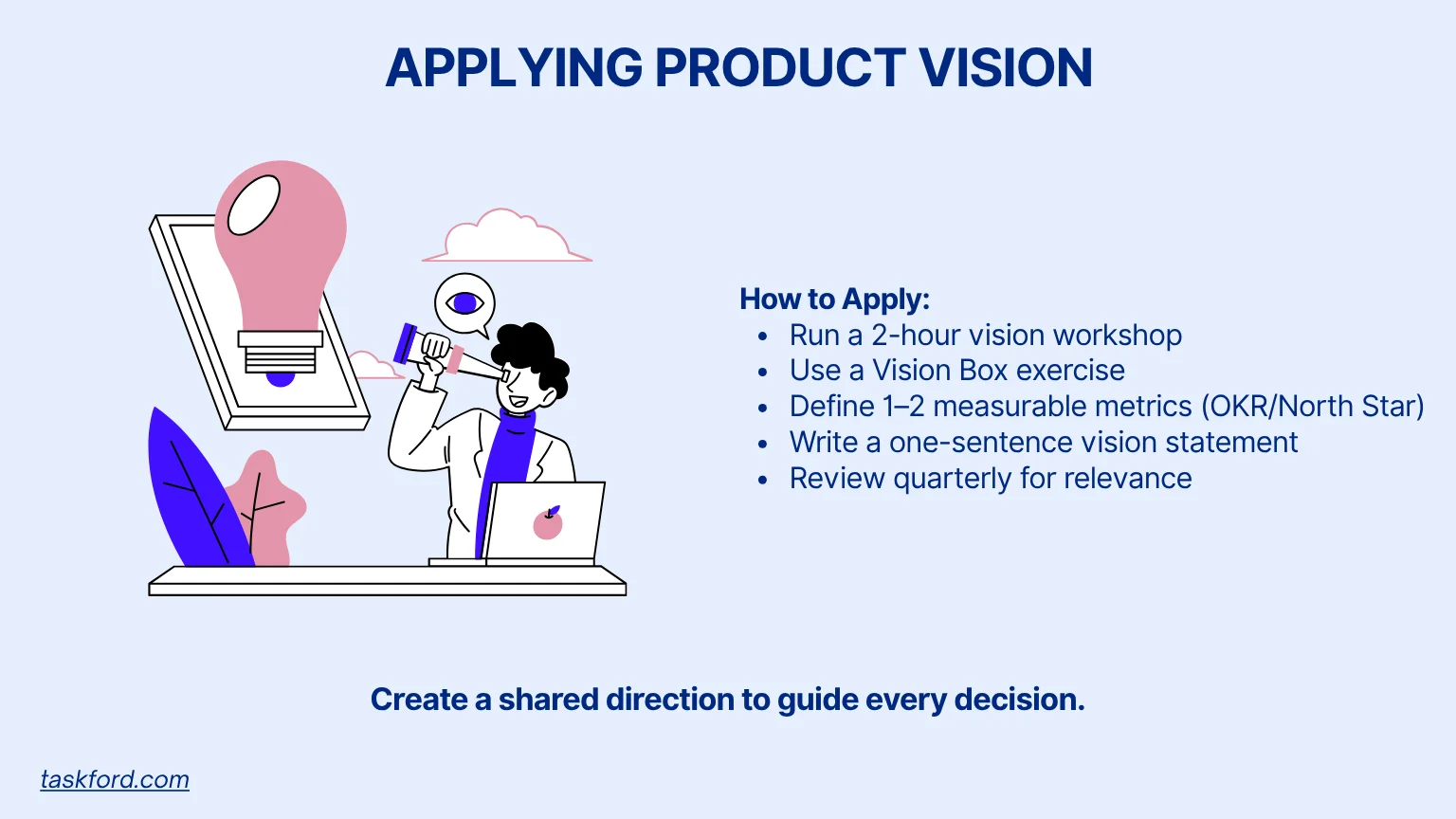
Objective: Create a shared direction to anchor every decision.
A clear product vision ensures all teams work toward the same purpose. Without it, organizations risk fragmented efforts, like a healthcare app team building features that don’t address patient needs.
How to Apply It:
- Run a 2-hour vision alignment workshop. Invite leadership, product owners, and developers to discuss customer pain points, market gaps, and business goals. Use a “vision box” exercise: teams sketch a product box cover highlighting key benefits (e.g., “Empowers patients with real-time health data”).
- Define 1-2 measurable success metrics. Use North Star metrics or OKRs, such as “Increase patient engagement by 20% within 12 months.” Create a one-page OKR template to document goals.
- Link vision to customer value. Write a one-sentence vision statement (e.g., “Simplify chronic disease management for patients”) and test it with a hypothesis: “If we provide real-time data, then patient adherence will improve by 15%.”
Practical Tip: Record the workshop in a shared doc and distribute it within 24 hours to maintain momentum. Use a checklist to ensure all stakeholders provide input.
Example: A healthcare startup ran a vision workshop, aligning on “streamlined patient monitoring,” which guided feature prioritization and increased user adoption by 18%.
Tools: Use a vision canvas template or a spreadsheet for OKRs.
Common Pitfall: Assuming the vision is final. Schedule quarterly 1-hour reviews to refine it based on customer feedback or market shifts.
Applying Level 2: Roadmap Planning
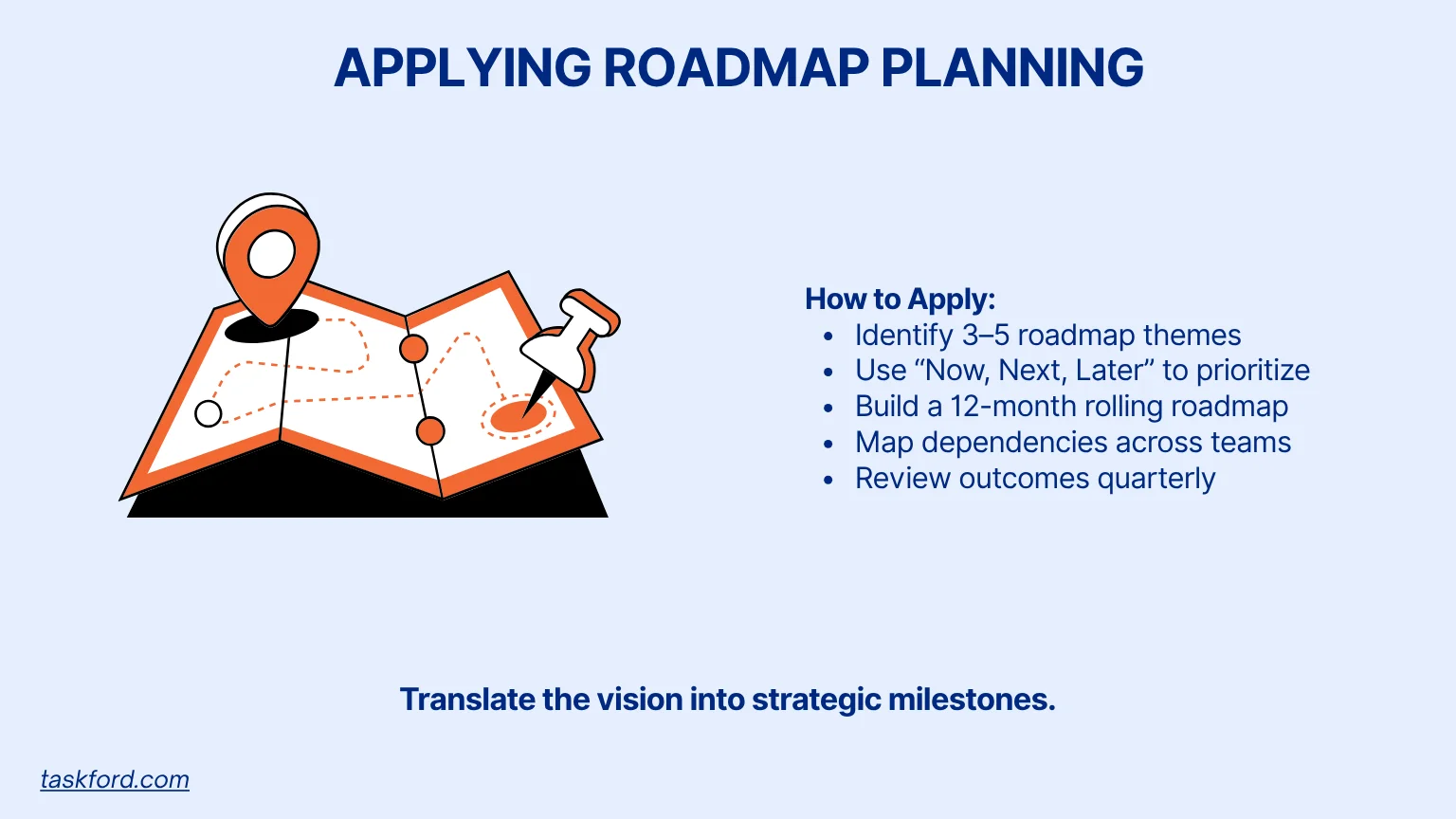
Objective: Translate the vision into actionable strategic milestones.
A product roadmap turns the vision into a 6-18 month plan, prioritizing outcomes over features. Without it, teams may chase low-value tasks, like a retail app team building minor UI tweaks instead of streamlining checkout.
How to Apply It:
- Identify 3-5 themes. Break the vision into high-level goals, such as “enhance checkout efficiency.” Map each to capabilities, like “one-click payment integration.” Use a “Now, Next, Later” template to prioritize.
- Build a rolling 12-month roadmap. Update it quarterly in a 90-minute review session. Focus on outcomes (e.g., “reduce checkout time by 25%”) and assign owners for each theme.
- Visualize dependencies. Create a dependency map in a 30-minute session to align cross-team efforts, especially for scaled teams with multiple squads.
Practical Tip: Use a one-page roadmap template to share with stakeholders. Include a “why” column linking each theme to the vision.
Example: A retail company roadmapped “faster checkout,” reducing cart abandonment by 20% in six months by prioritizing one-click payments.
Tools: Use a spreadsheet for roadmap templates or a project management tool like TaskFord for tracking.
Common Pitfall: Overloading the roadmap with features. Limit to 3-5 outcomes per quarter to maintain focus.
Applying Level 3: Release Planning
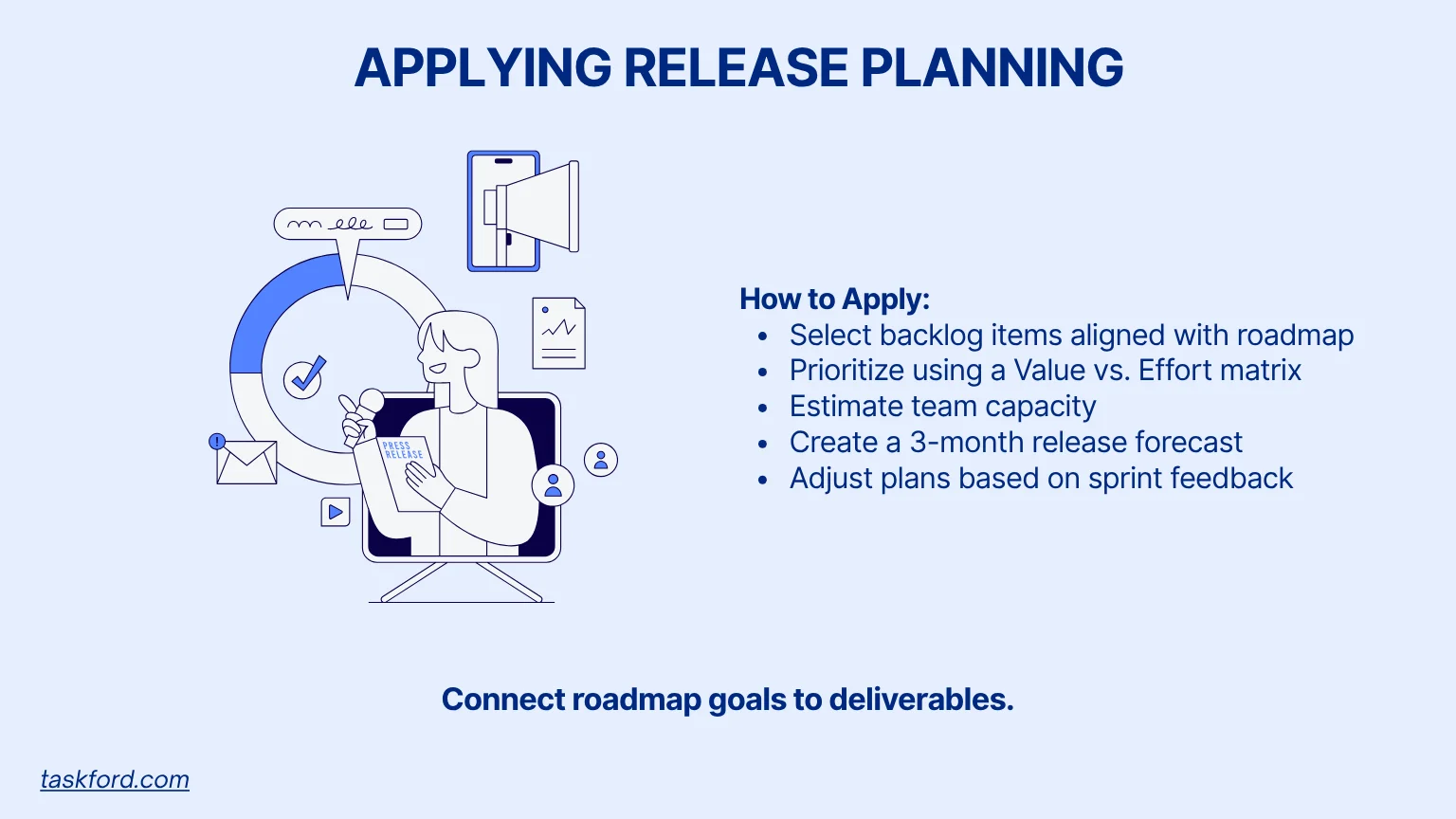
Objective: Connect strategic plans to tactical execution.
Release planning bridges roadmap goals to deliverables, ensuring teams deliver value within 1-6 months. Without it, dependencies can derail progress, as seen when a tech team’s unsynced releases caused integration delays.
How to Apply It:
- Identify backlog items. In a 1-hour workshop, select items that support roadmap outcomes (e.g., “payment gateway integration” for “faster checkout”). Use a prioritization matrix (Value vs. Effort) to rank tasks.
- Estimate capacity. Analyze historical velocity (e.g., 20 story points per sprint) to set realistic goals. Create a capacity planning spreadsheet to track.
- Create tentative release forecasts. Build a 3-month forecast with a 10% buffer for discovery. Update biweekly in a 30-minute review.
Practical Tip: Use a shared release calendar (downloadable template) to align squads and flag dependencies early.
Example: A tech team synchronized three squads on a payment feature release, delivering on time and reducing errors by 15%.
Tools: Use a spreadsheet for capacity planning or a project management tool for forecasts.
Common Pitfall: Treating releases as fixed. Treat them as iterative cycles, adjusting based on sprint feedback.
Applying Level 4: Iteration/Sprint Planning
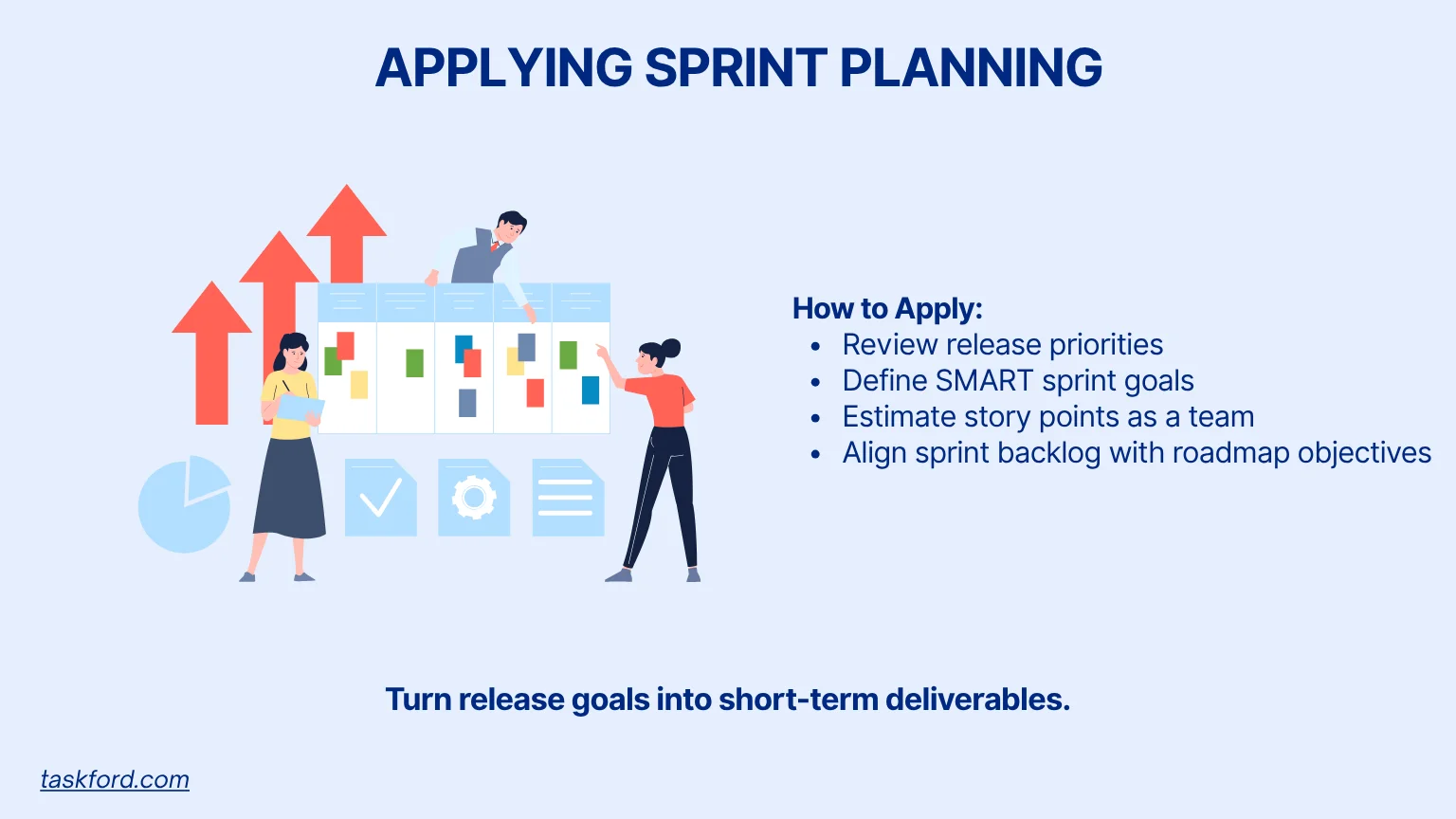
Objective: Turn release goals into focused, short-term deliverables.
Sprint planning drives incremental value every 1-2 weeks, aligning with release goals. Without alignment, teams may deliver low-impact features, like a team optimizing a rarely used button instead of critical functionality.
How to Apply It:
- Review release priorities. In a 1-hour sprint planning session, revisit release goals to select backlog items (e.g., “improve payment flow”). Use a sprint goal template to define outcomes.
- Create SMART sprint goals. Ensure goals are Specific, Measurable, Achievable, Relevant, and Time-bound (e.g., “Reduce payment errors by 10% in 2 weeks”).
- Let teams estimate. Use historical velocity to assign story points in a 30-minute estimation session, avoiding top-down pressure.
Practical Tip: Create a sprint planning checklist: confirm release alignment, draft SMART goal, finalize backlog. Share via a shared doc.
Example: A mobile app team set a SMART goal to “streamline login,” reducing user complaints by 12% in one sprint.
Tools: Use a spreadsheet for sprint goal templates, TaskFord for backlog tracking, or a project management tool for estimation.
Common Pitfall: Isolated sprint planning. Always link goals to release and roadmap objectives.
Applying Level 5: Daily Planning
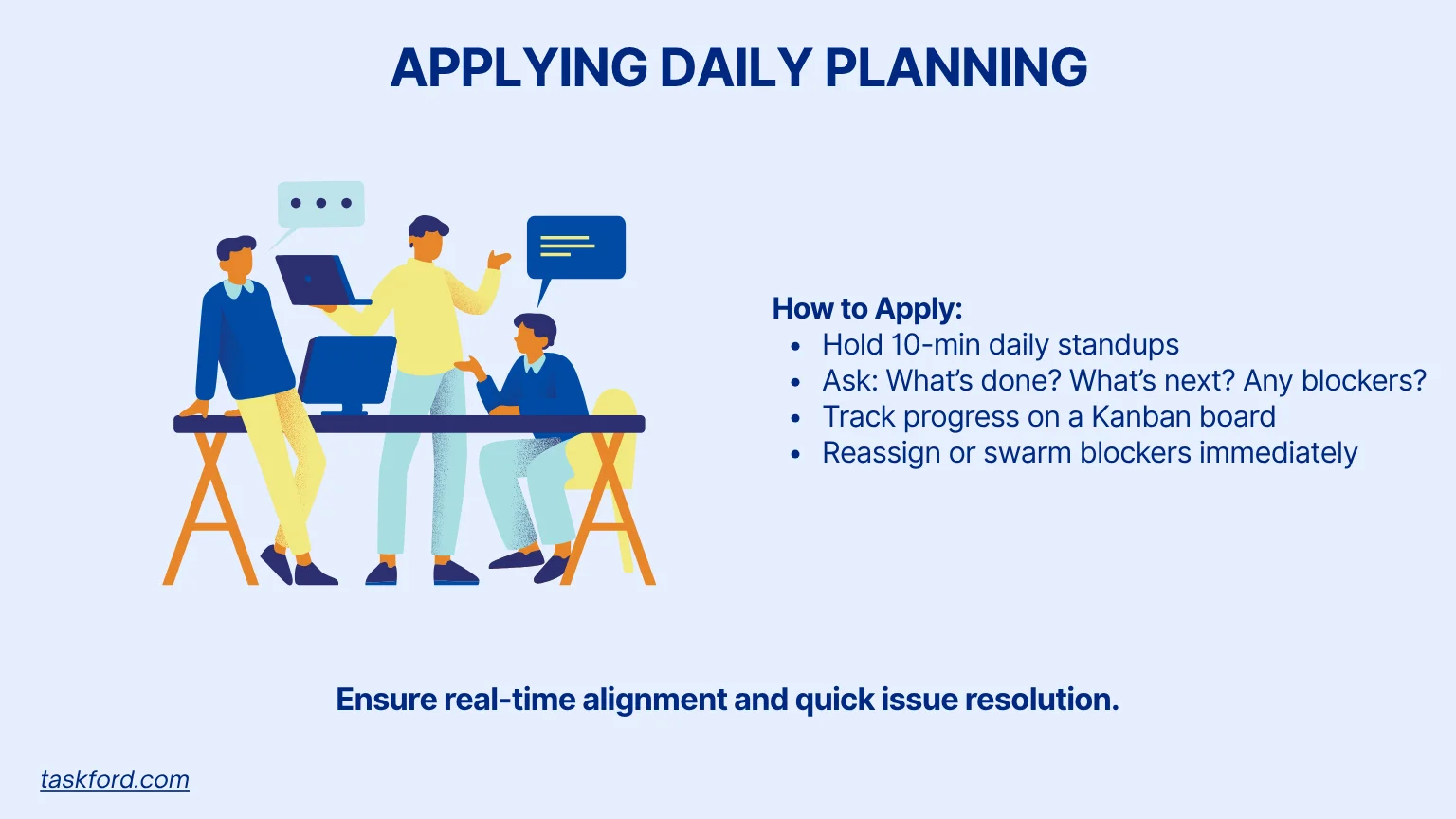
Objective: Enable real-time alignment and adaptability.
Daily planning ensures teams stay on track, resolving blockers quickly. Without focus, standups can become status reports, delaying progress, as seen when a team wasted time discussing non-urgent updates.
How to Apply It:
- Hold 10-minute daily standups. Use a 3-question script: What’s done? What’s next? Any blockers? Assign a facilitator to keep discussions action-focused.
- Use visual management. Set up a Kanban board to track tasks (e.g., To Do, In Progress, Done). Monitor cycle time to spot bottlenecks.
- Empower teams. Allow reassigning tasks or swarming blockers in real-time, using a decision log to track changes.
Practical Tip: Use a downloadable standup script and timer to enforce 10-minute meetings. Add a 10-minute weekly mini-retrospective to refine processes.
Example: A development team used a Kanban board to resolve a server issue in 24 hours, avoiding a sprint delay.
Tools: Use TaskFord for Kanban boards, a spreadsheet for cycle time tracking, or Slack for async updates.
Common Pitfall: Status-heavy standups. Focus on blockers and next steps to maintain agility.
Diagnosing and Improving Your Agile Planning Maturity
Regular assessment ensures the 5 levels evolve with your organization, preventing stagnation. For example, a team with weak daily planning might face recurring bottlenecks. This will help strengthen planning through continuous improvement, which also strengthens agile project management discipline.
How to Apply It:
- Assess maturity. Use a downloadable maturity matrix template to score each level (e.g., vision clarity: 3/5, daily planning: 2/5). Conduct a 1-hour team assessment quarterly.
- Create improvement actions. For weak areas (e.g., vague vision), assign actions like “run a vision refresh workshop” or “train on Kanban.” Document in a shared action plan.
- Review quarterly. In a 30-minute review, compare scores and adjust practices. Share updates via a team dashboard.
Practical Tip: Use a survey (e.g., 5 questions on alignment) to gather team feedback during assessments.
Integrating All 5 Levels of Agile Planning in Your Organization
Isolated planning levels create silos, reducing efficiency. Integration ensures every task supports the vision, as demonstrated by a retail team that aligned squads to cut delivery delays. This will help create a unified agile planning system
How to Apply It:
- Synchronize cadences. Align quarterly vision/roadmap reviews, biweekly sprint planning, and daily standups. Use a downloadable planning calendar template to schedule.
- Use a traceability model. Link each sprint goal to a roadmap theme and vision. For example, a task (fix checkout bug) supports a sprint goal (improve checkout), roadmap theme (user retention), and vision (seamless shopping experience). Visualize with a Miro diagram.
- Align remote/hybrid teams. Use virtual Kanban boards and async updates via Slack. In a 30-minute monthly sync, review connections across levels.
Practical Tip: Create a shared dashboard to display vision OKRs, roadmap progress, and sprint status, ensuring transparency.
Tools: Use Google Calendar for rhythm templates, or a project management tool like TaskFord for dashboards to track results.
Example: A distributed retail team used a dashboard to align three squads, reducing miscommunication by 40%.
Measuring Success Across the 5 Levels with Practical Metrics
Measuring the 5 levels of agile planning ensures alignment and drives improvement. A clear scorecard helps teams quantify success without complexity and track planning effectiveness with simple metrics.
How to Apply It:
-
Define metrics by level:
- Vision: OKR achievement % (e.g., 80% of user engagement goal met).
- Roadmap: Outcome delivery % (e.g., 4 of 5 themes completed).
- Release: On-time delivery % (e.g., 85% of releases met forecast).
- Sprint: Goal completion % (e.g., 90% of sprint goals achieved).
- Daily: Cycle time (e.g., average task completion in 1.5 days).
-
Use a downloadable scorecard template. Log metrics monthly in a spreadsheet, assigning scores (1-5) per level.
-
Gather team feedback. Use a 5-question survey (e.g., “Are sprint goals clear?”) to assess alignment and morale.
Conclusion
The 5 levels of agile planning create connections, not constraints. From vision workshops to daily standups, each level ensures teams deliver value while staying adaptable. Start small with a vision statement or a single sprint goal, using templates to streamline implementation. With consistent practice, these levels will align daily tasks with strategic objectives, driving measurable outcomes.
True agility emerges when every plan, from daily tasks to long-term roadmaps, works in harmony. By applying the 5 levels of agile planning with practical tools and metrics, you’ll transform your agile project management into a disciplined, dynamic system that delivers results.
Learn more
- How Long Is a Sprint in Agile? 1-Week vs 2-Week vs 4-Week Sprints
- Scrum vs Sprint: Why the Debate Exists and What Teams Really Need to Understand
- What is Project Management? The Complete First Guide for Newbies
Making work simpler,
smarter, and more connected
Join our waitlist and be notified first.

Related Blog
Subscribe for Expert Tips
Unlock expert insights and stay ahead with TaskFord. Sign up now to receive valuable tips, strategies, and updates directly in your inbox.



